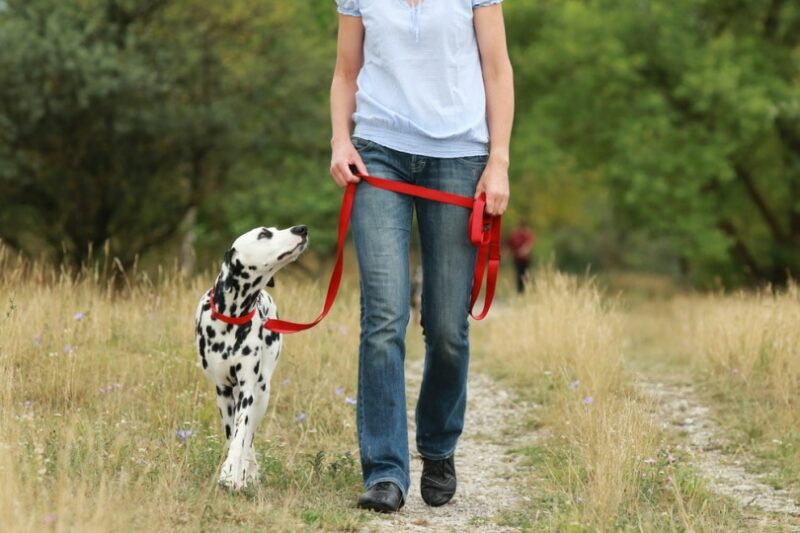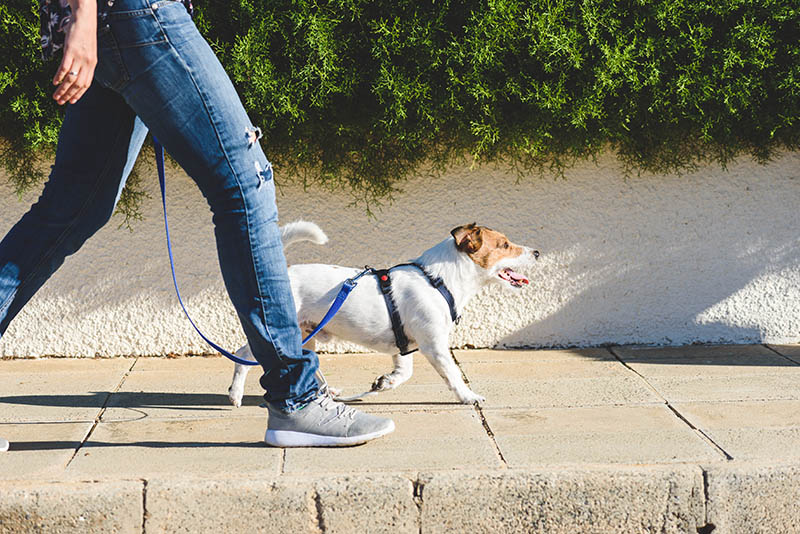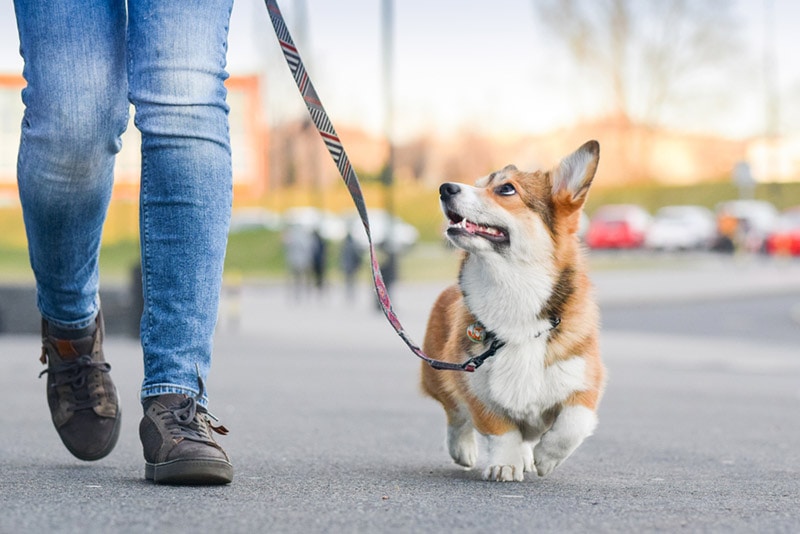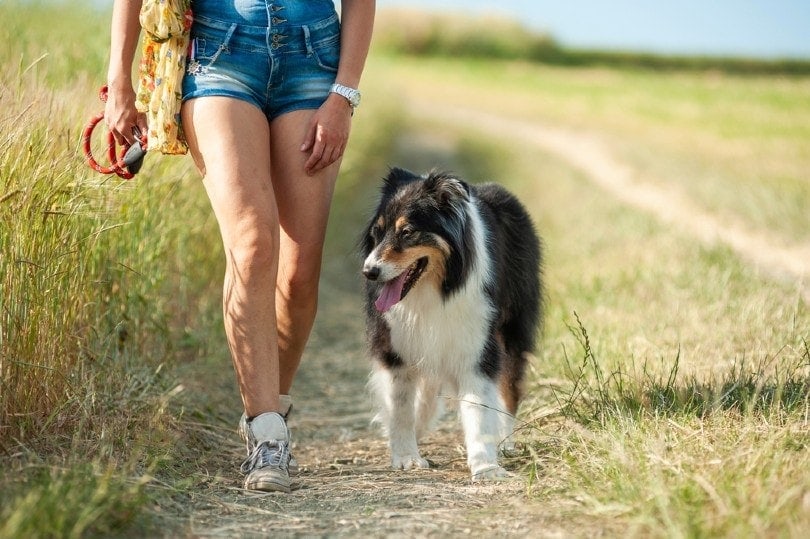When Is Walk Your Dog Month 2024? Purpose & How to Celebrate

Updated on

January is the month for New Year’s resolutions, so why not add walking your dog to your 2023 list; January is Walk Your Dog Month! Walk your pet month is an opportunity to pause scrolling and get your dog off the sofa so you can move together.
There are plenty of excuses not to go walking with your dog, but Walk Your Dog Month in January reminds you of the benefits of getting out into the fresh air with your companion. Here is what you need to know about Walk Your Dog Month!
What Is Walk Your Dog Month?
Walk Your Dog Month takes place in January and provides a reminder to dog parents about the benefits and importance of getting your dog out for a daily walk. No matter which breed or age your dog is, a daily walk is essential to their health.
Even a short walk with your dog can keep your companion happy and healthy. The benefits of a walk are often underrated, but Walk Your Dog Month helps highlight all its benefits and helps encourage dog owners to enjoy nature with their companions.

Why Is Walk Your Dog Month Important?
One of the primary reasons Walk Your Dog Month is so important is because it helps raise awareness about pet obesity. Recent statistics show that about 56% of dogs in the USA are overweight or obese. This equates to over 50 million dogs, and what’s sad is that this number is still likely to increase.
Overweight dogs are those who weigh at least 10% over their ideal body weight, while obese dogs are those who weigh 20% over. Unfortunately, even though a chubby dog may seem cute through an owner’s eyes, the truth is that obesity can lead to further health conditions in dogs, such as:
- Pancreatitis
- Arthritis
- Diabetes
- Kidney disease
- Compromised respiratory system
- Decreased quality of life
- Obvious weight gain
- Exercise intolerance
- Decreased energy
- Tight collar or harness
Regular walks can be a significant help in preventing and treating obesity and overweight dogs. It only takes a few minutes of your day and can have many other benefits too!
How Is Walking Your Dog Beneficial?
As we mentioned before, walking your dog is a great activity to do with your dog that can help maintain their weight and help prevent obesity. It is an excellent way for you and your dog to stay in shape.

Weight Control and Health Benefits
Walking your dog is great for your dog’s health, which means there will be fewer trips to the vet! Other than weight control, a daily walk of at least 20–30 minutes a day can help keep your dog’s joints healthy, help your dog get better sleep, and help regulate their digestive system.
Mental Health Benefits
Physical activity like walking can also improve your dog’s mental health. It releases endorphins that help keep your dog happy and elevate their spirits. It’s a chance for them to get socialized, explore their surroundings, use their nose to sniff around and meet new dogs and humans.
Bonding Opportunities
One of the most overlooked benefits of walking your dog is how much it can strengthen your bond and build trust. By having a daily routine of walking your dog, they will be excited about spending time with their owner. Your dog will gain more confidence and trust in you, and it’s an excellent opportunity for you to spend some one-on-one time with your companion. You will also get to know your dog and learn more about their body language and what they do and do not enjoy.
How Often Should You Walk Your Dog?
How often you should walk your dog depends on their age, health, breed, and activity levels. Younger dogs and energetic dogs will need more frequent walks, while senior dogs or dogs with health issues will do fine with shorter walks.
The general rule of thumb is that your dog should walk for five minutes for each month of their age for one or two sessions a day. It’s best to talk to your vet about your dog’s exercise needs, but at least a 20-minute walk will keep most moderately energetic breeds happy and healthy.

How Can You Take Part in Walk Your Dog Month?
Walking your dog daily is the obvious way to celebrate walk your dog month, but there is much more that you can do! You can change your walking route to make things more exciting or treat your dog to a new leash or harness. You can join a dog-walking group or even organize one yourself! Get friends and family to spread the word, and meet at a designated starting point to go on a group dog walk that you and your dog will love!
You can spread the word and encourage other pet parents to get out there with their companions and don’t forget to share photos of you and your dog living your best lives while on your walk together.
How to Walk Your Dog Safely
While walking your dog can provide significant benefits, you must also ensure your dog is safe. Here are some tips to keep your dog safe while on your daily walk:
- Ensure your dog’s harness is not too tight or too loose, and make sure it is comfortable.
- Use a harness and leash at all times!
- Walk with treats to keep up with training.
- Walk in front of your dog to establish the leader role and check the path for dangers like snakes.
- Allow your dog to sniff around as they please. It is their primary means of gathering information about their surroundings.
- Use dog booties if the walking surface is too hot or you are walking over snow. You must always protect your dog’s paws!
- Check your dog’s paws for thorns, cuts, bruises, or splinters after a walk.
- Check your dog for ticks after a walk if you have walked through long grass.
- Carry water to keep your dog hydrated.
- Ensure your dog has an ID tag or is microchipped in case you get separated while walking.
- If walking in misty or low light conditions, ensure your dog has a reflective harness and leash.
Final Thoughts
Walk Your Dog Month takes place in January. It is a time dedicated to creating awareness about the importance of taking your companion out for a walk. A short walk of 20–30 minutes can provide physical and mental benefits, and it is vital to create awareness due to the pet obesity statistics in the USA.
Obesity can lead to further health issues for your dog, and doing something as simple as walking your dog can help prevent them from becoming overweight or obese. So, turn off the TV, get out your dog’s leash and harness, and start creating a daily routine for you both to get active and bond and don’t forget to spread the word this January!\
Featured Image Credit: absolutimages, Shutterstock













